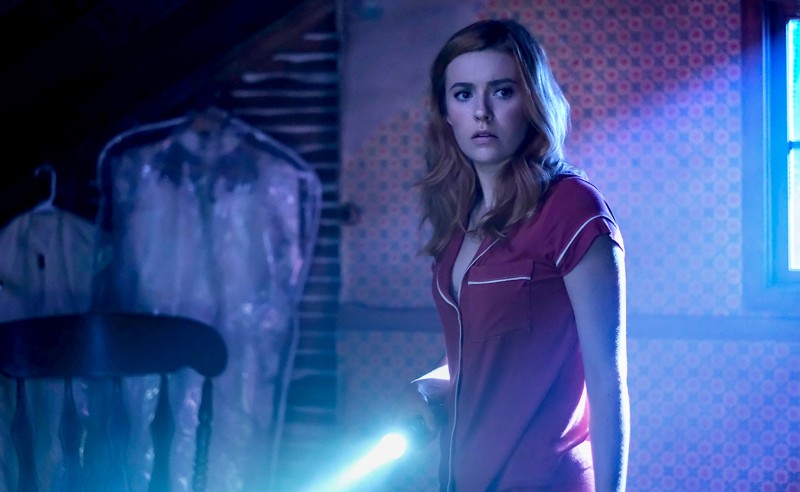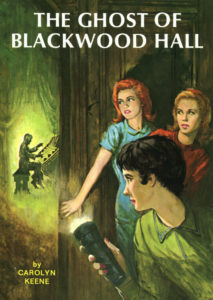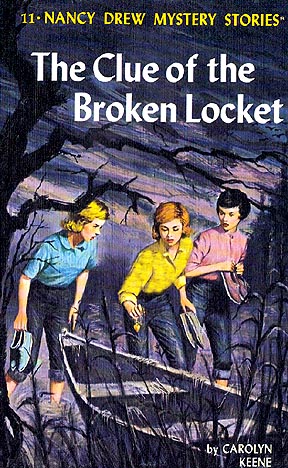This week, the CW premieres its newest television show: an hour-long weekly mystery serial called Nancy Drew. Reviving the famed adolescent sleuth as a battleborn teen, the show promises two intertwined mysteries: there is a murder and there is a ghost. It also promises to be just as moody and chiaroscuroed as another CW network show, my beloved, stupid Riverdale, whose ponytailed and dogged teen heroine Betty Cooper both embodies and identifies with the character Nancy Drew, solving mysteries in her small, suburban hometown, because its adults don’t know how.
Key to understanding the plot of any Nancy Drew story (as well as many, many other texts in twentieth-century young-adult entertainment, from Harry Potter to Scooby Doo) is accepting that grown-ups cannot fix problems, only create them. Teenagers, old enough to understand the adult world while young enough to see through it, are motivated to take justice into their own hands, knowing that if they themselves do not, no one will. Upon seeing Nancy at a crime scene, in the pilot episode of the CW’s adaptation, the sheriff growls her full name in lieu of a greeting. “Why does he say your name like that?” asks Bess, another teenager. The Sheriff responds, “She used to complicate my job.” George Fan, another teen, then articulates show’s (proposed) chief gambit in the form of a punchline: “You mean, do it for you?” (Indeed, the scene goes down very Veronica Mars.)
* * *

This new Nancy Drew show, which stars Kennedy McMann as the resolute young detective, duly promises to disparage the resistance society has to letting a teenaged girl call BS on the mismanagement of serious problems. But the history of Nancy Drew taking on adult incompetence is not always so pessimistic (rather, is not always so clearly a cause for pessimism). Historically, in the earlier Nancy Drew novels, many adults have welcomed Nancy’s assistance in crime-solving, including her father, Carson Drew, a lawyer who recruits her help all the time. In the earliest novels, the police and other authorities are dependably, publicly grateful for her help.
The original Nancy Drew stories, published starting in 1930 by ghostwriters for the Stratemeyer Syndicate under the pen name Carolyn Keene, championed a kind of Depression-era mindset: that all able-bodied individuals, including children, should pitch in and labor for a greater good. But this is one of the few indicators of the novels’ shared temporal setting. The Nancy Drew mysteries are startlingly, escapistly devoid of any hallmarks of an economic recession—there are no obvious signs like breadlines, shantytowns, or starving children, no subtler references to families pinching to save where they can, no background noise about political letdowns or governmental ineffectuality or crumbling infrastructure. What there is, is robbery. This is how the Depression worms its way into the stories: people have valuable things stolen from them, and so are down on their luck, and Nancy Drew will help retrieve their missing possessions. But this is done in the larger context of a prosperous world. As Troy Boone, a scholar at the University of Pittsburgh, writes:
“[T]he novels—which first appeared and achieved their great popularity during the Depression years—fantasize a redistribution of wealth resulting not from a radical transformation of the economic system but from exactly the social coalescence of middle-class identity and disavowal of working-class consciousness that has become the dominant feature of American ideological life in the second half of the twentieth century.”
Nancy Drew herself is only identifiable as a Depression-Era archetype because she models a kind of bootstrapping spirit relevant to the decade but gratuitous to the booming, alternative universe in which she lives. This gung-ho spirit is also checked by other social factors, though, causing her to embody diverging understandings of feminine identity, ability, and power. As much as she is “a thrill-seeker” or “adrenaline junkie,” in the words of Caroline Reitz, a scholar at CUNY, she is also a paragon of domesticity, social conservatism, and virtuous womanhood. She may be a badass, but she’s construed as one through a paternalistic, constraining gaze, as always being slim, attractive, and neat—always being a “good girl.”
But the CW’s Nancy Drew offers a new kind of take on this character, presenting a Nancy Drew in a totally modern age, complete with the modern age’s two main signifiers: an iPhone and disillusionment. Nancy is not a millennial, it is worth pointing out, she’s Gen-Z (she’s in high school circa now, which places her birth post-2000). Making Nancy Drew a Gen-Z-er supplies her with an awareness and a grit that fulfills the character’s original bandwidth. As The New York Times explains:
“Millennials, after all, were raised during the boom times and relative peace of the 1990s, only to see their sunny world dashed by the Sept. 11 attacks and two economic crashes, in 2000 and 2008. Theirs is a story of innocence lost… Generation Z, by contrast, has had its eyes open from the beginning, coming along in the aftermath of those cataclysms in the era of the war on terror and the Great Recession…”
The Nancy Drew of the 1930s was empathetic, sympathetic, and energetic about helping someone in need, but, with her lawyer father and upper-class background (the Drews employ a full-time housekeeper, for example, and live in “River Heights”), she was isolated from personally experiencing social or economic danger. The CW’s new incarnation of Nancy Drew as a Gen-Z-er, then, supplies a meaningful cultural context to her preternatural dyed-in-the-wool grit. She’s a young woman already wise to the unfair ways of the world, already aware of the ineffectuality of bureaucracy and jaded by the indifference of society to those it has screwed over.
Nancy Drew herself is only identifiable as a Depression-Era archetype because she models a kind of bootstrapping spirit relevant to the decade but gratuitous to the booming, alternative universe in which she lives.
Nancy does not have to lose her innocence to arrive at her disposition, in this adaptation—though maybe someone else does; indeed, the gambit of the CW show is that a wealthy socialite has been murdered, maybe at the hands of “Dead Lucy” Sable, the unhappy ghost of a woman who fell off a cliff in 2000 (the year of a Recession, but who’s counting?). Shots of her tombstone tell us she was born in 1983, so, really, the CW’s Nancy Drew TV show is haunted by a millennial—revealing the show’s possible internalization, even inadvertently, of the letdown and subsequent limbo experienced by the generation. (What is a ghost, really, if not someone who is strenuously unfulfilled to the point of stagnation?)
And so Nancy Drew’s promise to fortify a plot about literal enchantment with a relevant culture of social disenchantment provides a thoughtful origin story, a “nurture” argument to explain the qualities that the 30s versions took to be Nancy’s “nature.” But the show’s insistence on reanimating Nancy in this way dovetails with another productive thing it cannot help but do. The Nancy Drew show promises to reveal a useful dimension about the character and what she means to our culture—and not even because the adaptation offers a re-staging of the usual formula or does new things with the characters. It does so by simply existing, in the first place.
* * *
Unlike with many figures in literature, whose myriad adaptations seem to dilute their pop-cultural canons rather than meaningfully contribute to them (cough, Dracula, cough), the character Nancy Drew is fulfilled exactly when there are so many—too many—of her. The original novels (which were reproduced voluminously and quickly, sometimes being rewritten and re-published in new editions just years after their original release dates) offered to its readers a woman whose skills multiplied in each installment—to the point where she became a young woman truly capable of anything.

In this way, it becomes hard to see Nancy as a single woman, so much as an embodiment of many different women—rather like Barbie, who is simultaneously a fashion model, a veterinarian, a paleontologist, a horseback rider, a babysitter, an actress, a flight attendant, a gymnast, a photojournalist, Katniss Everdeen, and a mermaid, depending on which packaging she lives in. So similarly, astoundingly a polymath is Nancy Drew—with the newer editions in the Grosset and Dunlap roster adding to her repertoire of abilities and training whatever skill would be advantageous for the case at hand. She is a champion skier, figure-skater, pilot, dancer, codebreaker, driver, horseback rider, what have you—as if the child of the Olympic Games and a MENSA exam.
But in addition to being so much of everything, in eighty-or-so years of retellings, she has been incarnated so many times, and so differently. In the super contemporary Nancy Drew: Girl Detective series, she uses a cell phone and drives a hybrid. She has been played, on screen and television, by Bonita Granville (1938-39), Pamela Sue Martin (1977-1979), Maggie Lawson (2002), Emma Roberts (2007), and Sophia Lillis (2019), while voiced by Lani Manella in the popular Nancy Drew computer game series from 1998 to 2015. Sometimes she’s a shy third-grader, in the Nancy Drew Notebooks book series; sometimes she’s a moody teenager with a tempestuous love life, as in the 80s Nancy Drew Files; sometimes she’s a college student who doesn’t really solve mysteries and just deals with drama, as in Nancy Drew on Campus; sometimes she teams up with the Hardy Boys; sometimes she’s an elementary school-student solving things as unordinary as who cut a wedding cake before the bride, like in Nancy Drew and the Clue Crew. Nancy Drew is everything, yes, and she is also everyone. Her pop-cultural existence calls to mind the “e unibus pluram” joke coined by David Foster Wallace two decades ago. Not “from many, one,” but “from one, many.”

But in all these bodies, she represents many major stages of young female growth and development. The fact that there are so many Nancys means that she is primed for maximum reach, multifarious identification—there is a Nancy waiting at every milestone to become a kind of role model. Though, it is very much worth saying, there has never been a non-white (and this is entirely a different issue, but also “non-skinny”) Nancy Drew, so, despite all her limitlessness, she offers a very limited psychical and social representation of female potential, and an ultimately harmful physical depiction of female superiority. (I should mention that, although the CW’s Nancy Drew will also be a white woman, the cast will be ethnically diverse, which is at least a good step.)
Nancy Drew’s specific perfection was engineered in a 30s context, to, as the writer Deborah Siegel points out, combine Victorian conceptions of womanhood with modern ones. The purpose of the original Nancy was to reassure a (white) culture that a more active woman was no less feminine, but also to inspire young women to be as dynamic as they wanted to be. In all likelihood, her ghostwriters belonged to the generation that had fought for women’s suffrage, the generation that celebrated the rebellious Victorian conception of the “New Woman.” The image of Nancy they created has, for the most part, outlived the social context, with the many iterations published in the following decades keeping its female sleuth relatively fixed.
And it is important that Nancy Drew does not seem too real, because who could realistically, literally live up to her? Like Barbie, Nancy Drew offers a double-standard of severe female empowerment.
Along this line of thinking (and this is not a hot take), the very many Nancy Drews out there also do something super helpful for the character: the more of her there are, the less truly real she feels. And it is important that Nancy Drew does not seem too real, because who could realistically, literally live up to her? Like Barbie, Nancy Drew offers a double-standard of severe female empowerment. While the suggestion that a woman can be anything/everything is exciting and motivating, these characters’ comprehensive competence can feel wearying. And it is also naïve to insist that a woman will be able to do everything she wants easily, without feeling burnt out, without receiving immeasurable pushback, while looking flawless the whole time. Which is not to say that young girls do or should read Nancy Drew because they crave realism, but to say that as we continue to reshape our hallowed characters, that we should ensure that these female characters are not idealized on behalf of the young (female) readers who will encounter them. The readers can do that work, themselves.
The CW’s Nancy Drew, in which a young woman apparently annoys male authorities for being an effective and justice-focused advocate and then refuses to be silenced, promises to recalibrate Nancy’s extra-ness to allow it to exist more meaningfully, to feel a little more possible in its empowerment, to speak more directly to its jaded audience, especially the diverse, accepting, but exhausted and hardworking Gen-Z culture primed to receive it. In any case, this is what the character needs. After all, how else to describe Nancy Drew if not with the phrase “nevertheless, she persisted?”

















